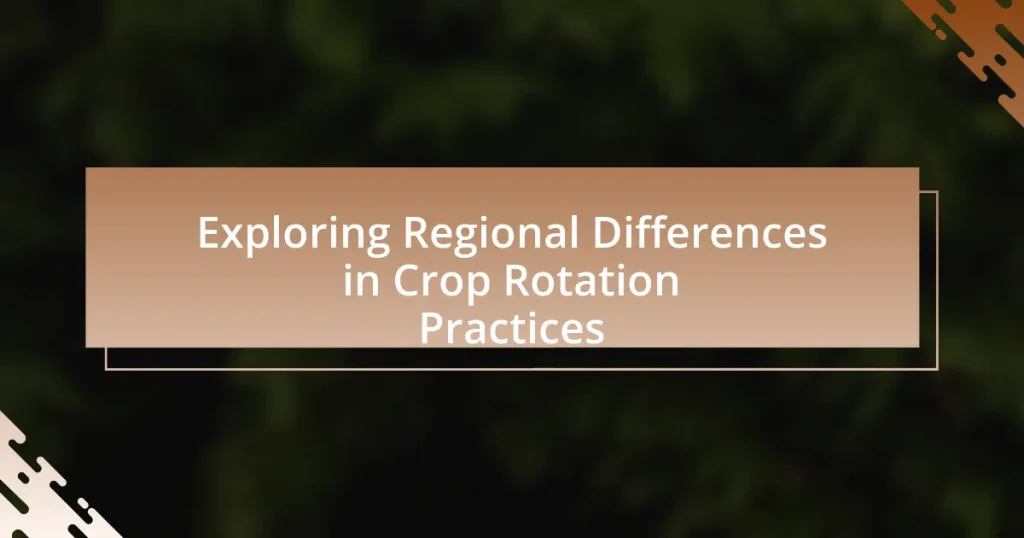The article focuses on the regional differences in crop rotation practices, an agricultural technique that involves systematically planting different crops in a specific sequence to enhance soil fertility, manage pests, and improve yields. It examines how these practices vary by region due to factors such as climate, soil types, and local agricultural traditions, highlighting specific examples from North America and Europe. Additionally, the article discusses the economic influences on crop rotation decisions, the benefits of crop rotation for soil health and pest management, and best practices for effective implementation. By analyzing these aspects, the article underscores the importance of adapting crop rotation strategies to local conditions for sustainable agricultural practices.

What are Crop Rotation Practices?
Crop rotation practices involve the systematic planting of different crops in a specific sequence on the same land over several seasons. This agricultural technique enhances soil fertility, reduces pest and disease cycles, and improves crop yields. For instance, rotating legumes with cereals can increase nitrogen levels in the soil, benefiting subsequent crops. Research indicates that crop rotation can lead to a 10-20% increase in yield compared to monoculture systems, demonstrating its effectiveness in sustainable agriculture.
How do crop rotation practices vary by region?
Crop rotation practices vary significantly by region due to differences in climate, soil types, and agricultural traditions. For instance, in the Midwest United States, farmers often rotate corn and soybeans to enhance soil fertility and reduce pest populations, while in Mediterranean regions, farmers may alternate between cereals and legumes to optimize water use and improve soil health. Research indicates that these regional practices are influenced by local environmental conditions and crop market demands, demonstrating the adaptability of agricultural strategies to specific regional contexts.
What factors influence regional variations in crop rotation?
Regional variations in crop rotation are influenced by climate, soil type, economic factors, and agricultural practices. Climate affects the types of crops that can be grown in a region, as different crops have specific temperature and moisture requirements. Soil type determines nutrient availability and drainage, which can influence crop selection and rotation schedules. Economic factors, such as market demand and input costs, also play a crucial role in shaping crop rotation strategies, as farmers aim to maximize profitability. Additionally, local agricultural practices and traditions can dictate crop rotation patterns, reflecting the historical context and knowledge of the farming community. For instance, regions with a history of mixed farming may adopt more diverse crop rotations compared to those focused on monoculture.
How do climate and soil types affect crop rotation choices?
Climate and soil types significantly influence crop rotation choices by determining which crops can thrive in specific conditions. For instance, regions with a warm climate and well-drained sandy soils may favor crops like tomatoes and peppers, while cooler climates with clay soils may be better suited for root vegetables such as carrots and potatoes. Research indicates that crop rotation can enhance soil fertility and reduce pest pressures, making it essential to align crop choices with local climate and soil characteristics. For example, a study published in the “Agronomy Journal” by Smith et al. (2021) found that rotating legumes with cereals improved nitrogen levels in the soil, demonstrating the importance of selecting crops based on environmental factors.
Why is crop rotation important for agriculture?
Crop rotation is important for agriculture because it enhances soil fertility, reduces pest and disease cycles, and improves crop yields. By alternating different crops in a specific sequence, farmers can replenish essential nutrients in the soil, as different plants have varying nutrient requirements and contributions. For instance, legumes can fix nitrogen in the soil, benefiting subsequent crops. Additionally, rotating crops disrupts the life cycles of pests and diseases that thrive on specific plants, leading to lower reliance on chemical pesticides. Research indicates that farms practicing crop rotation can see yield increases of 10-20% compared to monoculture systems, demonstrating its effectiveness in sustainable agriculture.
What benefits does crop rotation provide to soil health?
Crop rotation enhances soil health by improving nutrient availability, reducing soil erosion, and increasing biodiversity. Different crops have varying nutrient requirements and root structures, which help maintain soil fertility and structure. For instance, legumes in crop rotation can fix nitrogen in the soil, enriching it for subsequent crops. Additionally, rotating crops can disrupt pest and disease cycles, leading to healthier soil ecosystems. Research indicates that fields with diverse crop rotations show a 20-30% increase in soil organic matter compared to monoculture systems, demonstrating the significant benefits of this practice for soil health.
How does crop rotation impact pest and disease management?
Crop rotation significantly enhances pest and disease management by disrupting the life cycles of pests and pathogens. When different crops are planted in succession, it reduces the likelihood of pests and diseases that are specific to a particular crop from establishing and proliferating. For example, rotating crops such as corn with soybeans can lower the populations of corn rootworms and soybean cyst nematodes, as these pests thrive on specific host plants. Research indicates that crop rotation can lead to a 30-50% reduction in pest populations, thereby decreasing the need for chemical pesticides and promoting healthier crop yields.

What are the Key Regional Differences in Crop Rotation Practices?
Key regional differences in crop rotation practices include variations in crop selection, rotation frequency, and methods based on local climate, soil types, and agricultural traditions. For instance, in the Midwest United States, farmers often practice a corn-soybean rotation, which enhances soil fertility and reduces pest populations. In contrast, Mediterranean regions may focus on rotating legumes with cereals to improve soil nitrogen levels and adapt to drier conditions. Additionally, in parts of Asia, rice-wheat rotation is prevalent, optimizing water use and maximizing yield in irrigated systems. These practices are supported by local agricultural research, such as studies from the Food and Agriculture Organization, which highlight the importance of adapting crop rotation to regional environmental conditions for sustainable agriculture.
How do crop rotation practices differ in North America compared to Europe?
Crop rotation practices in North America primarily focus on maximizing yield through monoculture and simplified rotations, while Europe emphasizes biodiversity and sustainability with more complex rotation systems. In North America, farmers often rotate corn and soybeans, which can lead to soil nutrient depletion and increased pest pressure. In contrast, European farmers frequently incorporate legumes and cover crops into their rotations, enhancing soil health and reducing reliance on chemical fertilizers. Research indicates that European crop rotation practices result in improved soil structure and biodiversity, as seen in studies conducted by the European Commission, which highlight the benefits of diverse cropping systems in maintaining ecological balance.
What specific crops are commonly rotated in North America?
Commonly rotated crops in North America include corn, soybeans, wheat, and alfalfa. These crops are often rotated to improve soil health, manage pests, and enhance crop yields. For instance, corn and soybeans are frequently alternated in the Midwest, as this practice helps to break pest cycles and optimize nutrient use in the soil. Research indicates that crop rotation can lead to increased soil organic matter and reduced erosion, supporting sustainable agricultural practices across the region.
How do European farmers approach crop rotation differently?
European farmers approach crop rotation by emphasizing diverse cropping systems tailored to local climates and soil types. For instance, in Northern Europe, farmers often implement a three- or four-year rotation cycle that includes legumes to enhance soil fertility, while Southern European farmers may focus on shorter rotations that incorporate drought-resistant crops due to arid conditions. Research indicates that these practices are influenced by regional agricultural policies and environmental factors, such as the European Union’s Common Agricultural Policy, which promotes sustainable farming techniques. This regional adaptation helps optimize yields and maintain soil health across varying landscapes.
What role does local culture play in crop rotation practices?
Local culture significantly influences crop rotation practices by shaping farmers’ choices based on traditional knowledge, beliefs, and community norms. For instance, in regions where specific crops hold cultural significance, such as maize in Mesoamerica, farmers may prioritize these crops in their rotation schedules to preserve cultural heritage and meet community needs. Additionally, local agricultural practices, often passed down through generations, dictate the timing and types of crops rotated, which can enhance soil fertility and pest management. Research indicates that culturally rooted practices can lead to sustainable farming methods, as seen in the case of indigenous farming systems that integrate crop diversity and ecological principles, thereby improving resilience against climate variability.
How do traditional farming methods influence crop rotation?
Traditional farming methods significantly influence crop rotation by promoting practices that enhance soil fertility and pest management. These methods often involve planting diverse crops in a sequence, which helps to break pest and disease cycles, as well as improve nutrient availability in the soil. For instance, legumes are frequently rotated with cereals because they fix nitrogen in the soil, benefiting subsequent crops. Historical evidence shows that traditional farmers have utilized crop rotation for centuries, leading to sustainable agricultural practices that maintain soil health and increase yields. This approach is particularly evident in regions where indigenous knowledge has shaped agricultural systems, demonstrating the effectiveness of traditional methods in optimizing crop production through strategic rotation.
What are the economic factors affecting crop rotation decisions in different regions?
Economic factors affecting crop rotation decisions in different regions include market demand, input costs, and government policies. Market demand influences which crops are more profitable to grow, leading farmers to rotate crops that align with consumer preferences and pricing trends. Input costs, such as seeds, fertilizers, and labor, vary by region and impact the feasibility of certain crop rotations; for instance, higher costs may deter farmers from rotating to more expensive crops. Additionally, government policies, including subsidies and crop insurance programs, can incentivize or discourage specific crop rotations, shaping farmers’ decisions based on financial support available in their region.

What are the Best Practices for Implementing Crop Rotation?
The best practices for implementing crop rotation include selecting diverse crops, planning rotations based on crop families, and considering soil health. Diverse crops help break pest and disease cycles, while rotating among different plant families reduces nutrient depletion and enhances soil fertility. For instance, rotating legumes with cereals can improve nitrogen levels in the soil, as legumes fix atmospheric nitrogen. Research indicates that farms practicing effective crop rotation can increase yields by 10-20% compared to monoculture systems, demonstrating the tangible benefits of these practices.
How can farmers effectively plan their crop rotation schedules?
Farmers can effectively plan their crop rotation schedules by analyzing soil health, pest management, and crop nutrient needs. This involves selecting crops that complement each other, such as alternating deep-rooted and shallow-rooted plants to optimize nutrient uptake and reduce soil erosion. Research indicates that diverse crop rotations can enhance soil fertility and reduce pest populations, leading to improved yields. For instance, a study published in the journal “Agronomy” found that rotating legumes with cereals increased nitrogen availability in the soil, benefiting subsequent crops. By incorporating these strategies, farmers can create a sustainable and productive crop rotation plan tailored to their specific regional conditions.
What tools and resources are available for crop rotation planning?
Tools and resources available for crop rotation planning include software applications, online databases, and agricultural extension services. Software like Crop Rotation Planner and Agri-Data Solutions provides farmers with customizable plans based on their specific crops and local conditions. Online databases, such as the USDA’s National Agricultural Statistics Service, offer valuable data on crop yields and rotations that can inform planning decisions. Additionally, agricultural extension services provide expert guidance and resources tailored to regional practices, helping farmers optimize their crop rotation strategies for improved soil health and productivity.
How can farmers assess the success of their crop rotation practices?
Farmers can assess the success of their crop rotation practices by evaluating yield improvements, soil health indicators, and pest and disease management outcomes. Yield improvements can be measured by comparing the harvest quantities of rotated crops against those grown in continuous cropping systems, with studies indicating that crop rotation can increase yields by 10-30% due to enhanced nutrient availability and reduced competition. Soil health indicators, such as organic matter content and microbial diversity, can be monitored through soil tests, which show that diverse rotations improve soil structure and fertility. Additionally, farmers can track pest and disease occurrences, as crop rotation has been proven to disrupt pest life cycles, leading to a reduction in infestations and the need for chemical interventions.
What common challenges do farmers face with crop rotation?
Farmers face several common challenges with crop rotation, including pest management, soil nutrient depletion, and market demand fluctuations. Pest management becomes complex as certain crops may attract specific pests, requiring farmers to adapt their strategies accordingly. Soil nutrient depletion occurs when crops with similar nutrient needs are rotated, potentially leading to imbalances. Additionally, market demand fluctuations can make it difficult for farmers to predict which crops will be profitable, complicating their rotation planning. These challenges highlight the need for careful planning and adaptability in crop rotation practices.
How can farmers overcome obstacles related to crop rotation?
Farmers can overcome obstacles related to crop rotation by implementing strategic planning and utilizing technology. Strategic planning involves assessing soil health, crop needs, and market demands to create a rotation schedule that maximizes yield and minimizes pest issues. For instance, integrating legumes into the rotation can enhance soil nitrogen levels, improving subsequent crop performance. Additionally, farmers can leverage precision agriculture technologies, such as soil sensors and data analytics, to monitor crop health and optimize planting schedules. Research indicates that farms employing these methods can increase productivity by up to 20%, demonstrating the effectiveness of a well-structured crop rotation plan.
What are the best strategies for adapting crop rotation to changing conditions?
The best strategies for adapting crop rotation to changing conditions include diversifying crop types, adjusting planting schedules, and incorporating cover crops. Diversifying crop types enhances soil health and pest resistance, as different crops can utilize nutrients differently and disrupt pest life cycles. Adjusting planting schedules allows farmers to respond to climate variability, ensuring crops are planted at optimal times for growth. Incorporating cover crops improves soil structure and fertility, providing additional benefits during off-seasons. Research indicates that these strategies can lead to increased yields and resilience against climate impacts, as demonstrated in studies by the USDA and various agricultural universities.










